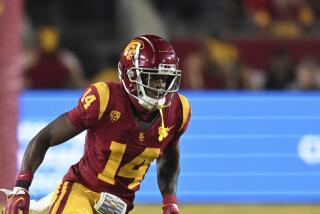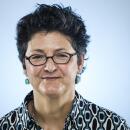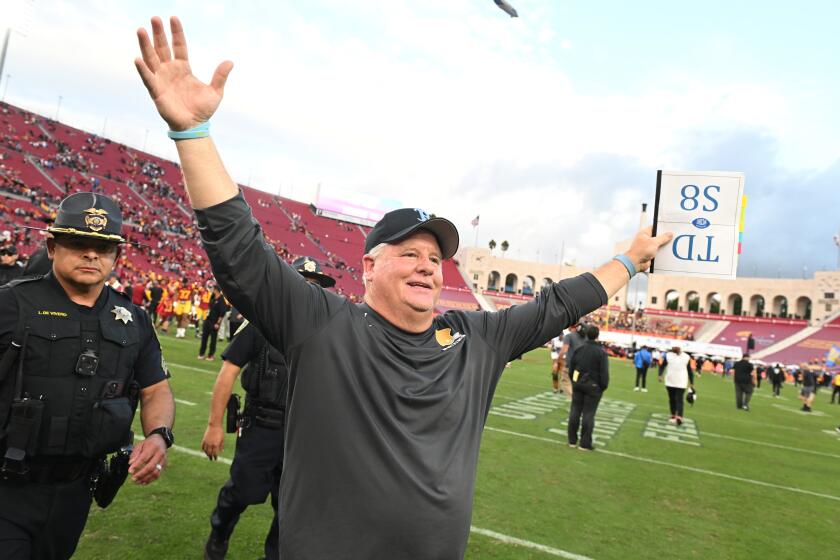These Programs Not Running Smoothly : Track and field: UCLA won’t have key performers Lewis and Williams. At USC, Bush takes over a program in ‘major ruin.’
- Share via
As UCLA Coach Bob Larsen prepared to begin the outdoor track and field season, he was greeted with the news that Steve Lewis, who won the 400 meters in both the 1988 Olympic Games and last year’s NCAA Championships, will forgo his remaining collegiate eligibility to train for the ’92 Olympics.
Then, Larsen was told that versatile sprinter Kevin Williams will skip track this spring to improve his fortunes as a running back on the Bruin football team.
“That really changed the picture,” Larsen said as he assessed UCLA’s prospects.
Larsen will get no sympathy from USC, whose outlook is best described as bleak.
The teams will compete Saturday when UCLA plays host to a men’s and women’s quadrangular meet against USC, Houston and Texas Christian. The first event begins at 11:30 a.m. at Drake Stadium.
After 20 years at UCLA, Jim Bush is the new head of USC’s combined men’s and women’s programs. Bush takes over a men’s team that his assistant, Mike Bailey, described this week as a “major ruin” and a young women’s team that shows promise but little else.
Add to that a lack of depth and the fact that nearly one-third of the men’s team will be involved in spring football practice, and it’s obvious that Bush faces a challenge.
UCLA is led by throwers, and both the men’s and women’s teams have experience and at least some depth. Eric Bergreen won the NCAA indoor shotput for the men’s team last month, as did Tracie Millett for the women. Millett is also the defending NCAA outdoor champion in both the shotput and the discus.
Millett is the cornerstone of a women’s team intent on breaking out of a streak of second places. Last season’s runner-up finish marked the third time the Bruin women have placed second in the national meet. Coach Bob Kersee has made winning the NCAA title his team’s goal this season.
“My focus is on the national championship,” Kersee said. “I’ve gone to three national championships in a row and I’ve come back with three silver medals. Anyone who has gotten to know Bobby Kersee knows I don’t like to lose.
“We will continue to dominate the dual meets and the Pacific 10 meet, which we have won four years in a row. But the one thing that still eludes me is the national championship.”
On paper, Kersee has the athletes to reach that goal. Millett has gained confidence to go along with her titles and says this will enable her to prevail even in the closest competition. She said this week she has learned to project a “national champion” attitude to intimidate competitors.
“Yeah, I try to milk that as much as I can,” she said, laughing. “I try to give that image. Sometimes it works, sometimes it doesn’t.”
Millett can be expected to score points in both the shot and the discus, but she’s not the only multi-point athlete on her team. Fellow senior Janeene Vickers is the defending collegiate champion in the 400-meter hurdles and will, according to Kersee, probably qualify for the NCAA meet in the 100, 200 and 400 plus both the 100 and 400 hurdles.
Said Kersee of Vickers’ apparent willingness to enter several events: “She laces on her spikes and stands beside me and runs what I tell her to run.”
The Bruins’ true multi-event performer--heptathlete Tonya Sedwick--will return to the seven-event discipline after concentrating on sprinting and long jumping last season. Freshman Shelia Burrell will also compete in the heptathlon and sprints, along with sprinters Angela Burnham and Caryl Smith.
Since UCLA’s men’s team will be without Lewis and Williams, its sights are more realistically set on doing well in the Pac-10 meet, which the Bruins won for three consecutive years before finishing third in 1990.
Bergreen will be the key, with the ability to score points in both the shot and the hammer throw. Mike Stevenson was an All-American at 400 meters last season and runs on two relay teams. Distance runner Mark Dani qualified for the NCAA meet in the 5,000 last season and returns for his senior year. Also returning is long jumper McArthur Anderson, who redshirted last year.
The Bruins lost to Texas last month to end a six-year undefeated dual meet streak.
As for his team’s Pac-10 competition, Larsen said: “Washington State looks good to win it. We’re in there with Oregon and Arizona to get second or third. This year, the team that wins the NCAA is probably going to score more than 35 points. We are really a year away from that kind of score.”
USC may be several years from regaining its former stature as a national power. Now, as in the past, the Trojans are led by outstanding sprinters. However, five members of the men’s track team have reported to spring football drills--including three of the four runners on two relay teams.
Two-time Olympic sprinter Barbara Edmonson, who coaches the male and female sprinters, is in her first year at USC, and she’s not used to watching her athletes being siphoned off by another sport.
“This is kind of new to me,” she said. “I’ve got a track team that is now playing football.”
Quincy Watts, a 400-meter runner, is undefeated this season, as is freshman sprinter Curtis Conway. The Trojans have some depth in the sprints--when the football players are on the track--but they are thin elsewhere. The team’s only thrower, Joe Cajic, is also participating in spring football.
A thrower is the brightest hope for USC’s women. Ashley Selman won the NCAA javelin title last season as a sophomore and has not lost this season. She is the Trojan woman closest to reaching the NCAA qualifying mark, although neither she nor any of her teammates has yet qualified.
However, USC’s excellent recruiting year--in which the Trojans netted Inger Miller, the nation’s top prep sprinter, and Felice Lipscomb, the top prep hurdler--may bode well for the future.
More to Read
Go beyond the scoreboard
Get the latest on L.A.'s teams in the daily Sports Report newsletter.
You may occasionally receive promotional content from the Los Angeles Times.







